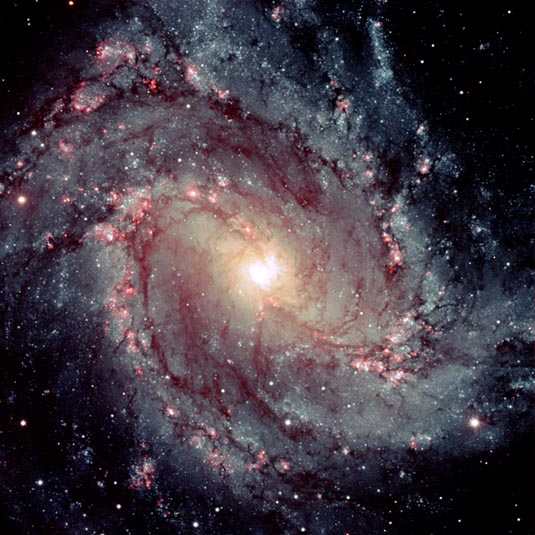
Spiral Galaxy
RA 13hr 37m 0.95s Dec -29° 51' 56.56"
Hydra
15 million light years
12.9' × 11.5'
7.5
6.83 x 6.80 arcminutes
North is 0.0° right of vertical
ESO
August 10, 2005
More M83: G0525 G0825 G0917 G0929 G1020 G1404 G1404(closeup)
ABOUT THIS IMAGE:
If our Milky Way were to resemble this one, we certainly would be proud of our home! The beautiful spiral galaxy Messier 83 (also known as the Southern Pinwheel Galaxy, M83 or NGC 5236) is a barred spiral galaxy approximately 15 million light-years away in the constellation Hydra. It is one of the closest and brightest barred spiral galaxies in the sky, making it visible with binoculars.
The image show clumpy, well-defined spiral arms that are rich in young stars, while the disc reveals a complex system of intricate dust lanes. This galaxy is known to be a site of vigorous star formation.
M83 was discovered by Nicolas Louis de Lacaille on February 23, 1752 at the Cape of Good Hope. Charles Messier added it to his catalogue of nebulous objects (now known as the Messier Catalogue) in March 1781
How does the Galaxy in which we live look like?
It is almost certain that we will never be able to send a probe out of our Milky Way to take a snapshot, in the same way as the first satellites could do to give us striking images of planet Earth. But astronomers do not need this to imagine what our bigger home resembles. And they have a pretty good idea of it.
The Milky Way with its several hundreds of billion stars is thought to be a relatively flat disc 100,000 light-year across with a central bulge lying in the direction of the constellation Sagittarius (The Archer) and six spiral arms. The Milky Way has most probably also a central bar made of young, bright stars.
If we can't take pictures of the Milky Way, we may photograph others galaxies which astronomers think look similar to it. The two galaxies presented in this release are just two magnificent examples of barred spiral galaxies. Messier 83 is seen face-on, and the other, NGC 4565 appears edge-on. Together, they give us a nice idea of how the Milky Way may appear from outer space.
These
images are based on data obtained with the twin FORS1 and FORS2 (FOcal
Reducer and Spectrograph) instruments attached to two ESO's 8.2-m Unit
Telescopes of the Very Large Telescope Array located on Cerro Paranal.
The data were extracted from the ESO Science Archive Facility, which contains
approximately 50 Terabytes [2] of scientific data and is, since April
1, 2005, open to the worldwide community. These invaluable data have already
led to the publication of more than 1000 scientific papers. They also
contain many nice examples of beautiful astronomical objects which could
be the theme of as many midsummer's dreams.